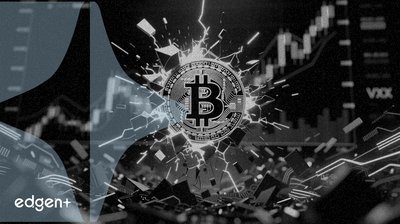
No Data Yet
Related News

La prima de volatilidad de Bitcoin sobre el VIX se amplía, señalando oportunidades de trading de pares en medio de la caída del mercado
## El evento en detalle La diferencia entre el **Índice de Volatilidad de Bitcoin (BVIV)** y el **Índice de Volatilidad CBOE (VIX)**, que mide la volatilidad esperada del S&P 500, se ha ampliado de manera notable. Esta divergencia se produce tras una fuerte caída en el mercado de activos digitales, donde los precios de **Bitcoin (BTC)** cayeron de un máximo de fin de semana de aproximadamente 91.000 dólares a menos de 85.000 dólares. El **Índice CoinDesk 20 (CD20)** más amplio disminuyó casi un 6% en 24 horas. El BVIV de Volmageddon, que rastrea la volatilidad implícita a 30 días para Bitcoin, se disparó a más del 55% durante las horas de negociación asiáticas antes de establecerse alrededor del 53%. La venta masiva provocó más de 637 millones de dólares en liquidaciones en todo el mercado de criptomonedas, con más de 430 millones de dólares provenientes de altcoins. Tokens como **Zcash (ZEC)**, **Ethena (ENA)** y **Celestia (TIA)** experimentaron pérdidas significativas del 20%, 16% y 14%, respectivamente. ## Implicaciones del mercado La ampliación de la prima de volatilidad ha abierto la puerta a estrategias sofisticadas de trading de pares. Esto implica que los traders tomen posiciones opuestas en los dos índices para capitalizar sus movimientos relativos. Por ejemplo, un trader podría vender futuros de BVIV mientras compra futuros de VIX, apostando a que la diferencia se reducirá. Tales estrategias requieren un capital significativo y un monitoreo continuo, lo que las hace más adecuadas para inversores institucionales y fondos de cobertura. La caída del mercado también ha impactado fuertemente las acciones relacionadas con las criptomonedas. Las acciones de **Coinbase (COIN)** y **Robinhood (HOOD)** cayeron más del 6%, mientras que **Strategy (MSTR)**, el mayor tenedor corporativo de Bitcoin, vio su acción desplomarse un 11%. Esto refleja una creciente ansiedad de los inversores y un sentimiento de aversión al riesgo más amplio. ## Comentarios de expertos Los analistas de **Deutsche Bank** atribuyen la venta masiva de criptomonedas a una combinación de ventas institucionales, toma de ganancias por parte de tenedores a largo plazo y una perspectiva más agresiva de la Reserva Federal de EE. UU. La incertidumbre se agrava por la estancada regulación de las criptomonedas en los Estados Unidos. Por el contrario, el banco de inversión **Benchmark** reiteró una calificación de "comprar" para **Strategy (MSTR)**, rechazando lo que llama una "narrativa apocalíptica". El analista de Benchmark, Mark Palmer, señaló que el precio de Bitcoin necesitaría caer por debajo de los 12.700 dólares —una disminución de aproximadamente el 86% de los niveles actuales— antes de que la compañía no pudiera cumplir con sus obligaciones de deuda convertible. Este comentario se produjo incluso cuando el **CEO de Strategy, Phong Le**, reconoció la posibilidad de vender Bitcoin si el valor de mercado de la compañía en relación con sus tenencias de Bitcoin disminuye significativamente. ## Contexto más amplio La reciente volatilidad del mercado no está ocurriendo en el vacío. Los comentarios agresivos del **gobernador del Banco de Japón, Kazuo Ueda**, insinuando una posible subida de tipos de interés, han ejercido presión sobre los activos de riesgo globales. Un yen más fuerte podría obligar a los fondos de cobertura a deshacer la "operación de carry trade del yen" —una estrategia de pedir prestado yenes a bajas tasas de interés para invertir en activos de mayor rendimiento como Bitcoin. Este viento en contra macroeconómico está contribuyendo a una huida hacia la seguridad, evidenciado por una salida de 3.600 millones de dólares de los ETF de Bitcoin al contado en noviembre, mientras que los activos tradicionales de refugio seguro como el oro han visto sus futuros subir casi un 7%. Las condiciones actuales están poniendo a prueba la integración de Bitcoin en carteras de inversión diversificadas, planteando preguntas sobre si se trata de una corrección a corto plazo o un ajuste de mercado más sostenido.

El aumento anómalo del 13% de Polkadot en el colapso generalizado del mercado de criptomonedas
## Resumen Ejecutivo El 2 de diciembre, el token nativo de Polkadot, **DOT**, registró un notable aumento de precio del 13 % hasta los 2,25 $, una desviación significativa de la tendencia predominante del mercado. Este aumento estuvo acompañado de un incremento del 34 % en el volumen de operaciones, lo que sugiere una entrada momentánea de compras institucionales o concentradas. Sin embargo, el movimiento se borró rápidamente a medida que el mercado de criptomonedas en general sucumbía a una fuerte liquidación, impulsada por una combinación de vientos en contra macroeconómicos y crecientes riesgos estructurales. Bitcoin (**BTC**) lideró la caída, rompiendo el nivel de soporte de 86.000 $ y desencadenando una cascada de más de 650 millones de dólares en liquidaciones en todo el mercado. ## La Anomalía de Polkadot En un mercado teñido de rojo, **Polkadot** proporcionó un breve momento de actividad alcista. El token rompió un nivel clave de resistencia técnica para alcanzar los 2,25 $. El movimiento estuvo respaldado por un aumento significativo del 34 % en el volumen de operaciones en comparación con su promedio de siete días, una métrica a menudo asociada con el interés institucional. Sin embargo, el repunte resultó insostenible. A medida que la presión de venta en todo el mercado se intensificaba, **DOT** revirtió sus ganancias, cayendo aproximadamente un 12 % para cotizar alrededor de los 2,00 $. Los datos de los mercados de derivados indicaron que las tasas de financiación para **DOT** se volvieron negativas, lo que implicaba que los operadores estaban en gran medida posicionados para una caída de precios, lo que finalmente se materializó. ## Contexto del Mercado: Liquidaciones y Miedos Macroeconómicos El espacio de activos digitales en general experimentó una desaceleración significativa, borrando las ganancias de la semana anterior. La caída del mercado se destacó por más de **$650 millones** en liquidaciones totales, siendo la gran mayoría ($580 millones) posiciones largas. Las principales criptomonedas registraron pérdidas sustanciales, con **Bitcoin (BTC)** cayendo aproximadamente un 6-7 % y **Ethereum (ETH)** cayendo alrededor de un 9-10 %. Otros altcoins sufrieron pérdidas aún mayores, incluido **Zcash (ZEC)**, que se desplomó más del 20 %, y tokens como **Ethena (ENA)** y **Celestia (TIA)**, que cayeron más del 14 %. ## Comentarios de Expertos sobre Riesgos Estructurales Los analistas de mercado señalan varios factores que exacerban la liquidación. La frágil liquidez del mercado y la escasa profundidad del libro de órdenes se han destacado como debilidades críticas. En un comunicado, **Farzam Ehsani**, CEO del intercambio de criptomonedas VALR, señaló: "La presión en todos los mercados se intensificó porque el libro de órdenes era poco profundo y el mercado carecía de la profundidad suficiente para resistir otro shock de liquidez macroeconómico." Sumándose a la incertidumbre, hay una decisión pendiente de **MSCI** sobre si excluir a las empresas con importantes tenencias de criptomonedas, como **Strategy (MSTR)**, de sus índices globales. Ehsani comentó sobre la situación, afirmando que tal cambio de regla podría desencadenar "ventas forzadas de las acciones de estas empresas y provocar importantes flujos de capital". Esta posible reclasificación ha introducido una sobrecarga estructural en el mercado, ya que los inversores anticipan el riesgo de ventas forzadas por parte de los fondos que siguen índices. ## Implicaciones Más Amplias y Vientos en Contra Globales La liquidación no ocurre en un vacío. Los comentarios agresivos del **Gobernador del Banco de Japón, Kazuo Ueda**, insinuando un posible aumento de las tasas de interés, han sacudido los mercados globales. Un yen más fuerte podría deshacer las operaciones de carry trade donde los inversores toman prestado yenes para comprar activos más riesgosos como las criptomonedas. Además, a pesar de las expectativas de un recorte de tasas por parte de la Reserva Federal de EE. UU., los rendimientos del Tesoro obstinadamente altos y un índice del dólar resistente están desafiando la narrativa tradicional de que una política monetaria más flexible alimenta directamente los repuntes de las criptomonedas. Para agravar estos problemas, el banco central de China reafirmó recientemente su postura sobre la ilegalidad de las criptomonedas, lo que indica un potencial para una nueva represión. El breve repunte de Polkadot, aunque notable, subraya en última instancia la vulnerabilidad del mercado a estas fuerzas macroeconómicas y estructurales dominantes.

SUI y ENA lideran desbloqueos de tokens semanales por más de $139 millones, presionando a los mercados
## Resumen Ejecutivo Esta semana, el mercado de criptomonedas se prepara para un aumento significativo en el suministro circulante de varios tokens, liderado por **Sui (SUI)** y **Ethena (ENA)**. Estos eventos programados desbloquearán más de $139 millones en activos previamente restringidos. Los desbloqueos de tokens son un componente crítico de la tokenomía de un proyecto, representando un evento inflacionario planificado que puede ejercer una presión considerable sobre los precios de los activos. La reacción del mercado será una prueba clave de la demanda de los inversores y el valor percibido a largo plazo de estos protocolos. ## El Evento en Detalle Los dos desbloqueos más destacados de la semana son: * **Sui (SUI):** El 1 de diciembre, la red Sui desbloqueó 55,54 millones de tokens SUI, valorados en aproximadamente $85 millones. Esta liberación constituye aproximadamente el 0,56% del suministro circulante del token. * **Ethena (ENA):** El 2 de diciembre, el protocolo Ethena tiene programado desbloquear tokens por un valor estimado de $54,3 millones. Esta inyección de nuevo suministro representa el 3,04% de su suministro circulante actual. Esto forma parte de un calendario de liberación gradual más amplio que se extiende hasta 2026. Otros tokens, incluidos **SANTOS**, **WAL** y **RED**, también están programados para desbloqueos más pequeños durante la semana, lo que contribuye al aumento general del suministro líquido en el mercado. ## Implicaciones para el Mercado La principal implicación de un gran desbloqueo de tokens es el potencial de una mayor presión de venta. A medida que los tokens se distribuyen a los primeros inversores, miembros del equipo y reservas de la comunidad, una parte de estos activos a menudo se liquida en el mercado abierto. Este aumento repentino en el suministro, si no se satisface con una demanda correspondiente, puede provocar una presión a la baja en los precios. Para **ENA**, el desbloqueo del 3,04% de su suministro circulante es un evento material que podría desencadenar una volatilidad a corto plazo. La capacidad del mercado para absorber estos nuevos tokens sin una caída significativa de precios dependerá del sentimiento actual del mercado, el volumen de negociación del activo y el comportamiento de los receptores de los tokens desbloqueados. Si bien programados y transparentes, estos eventos siguen siendo un punto clave para los traders que evalúan los riesgos del lado de la oferta. ## Tokenomía y Cronogramas de Adquisición Una mirada más profunda a la tokenomía revela los mecanismos detrás de estos desbloqueos: * **Sui (SUI):** El protocolo tiene un suministro total limitado a 10 mil millones de tokens. Los desbloqueos actuales son parte de un cronograma de adquisición a largo plazo para varias partes interesadas, incluidos los primeros contribuyentes (adquisición de 72 meses), los inversores de la Serie A (adquisición de 11 meses), los inversores de la Serie B (adquisición de 24 meses) y una Reserva Comunitaria (adquisición no lineal de 82 meses). Estas liberaciones estructuradas están diseñadas para gestionar la inflación durante varios años. * **Ethena (ENA):** Más de 6.8 mil millones de tokens ENA están actualmente en circulación, con casi 6 mil millones restantes bloqueados. Estos tokens bloqueados están designados para la fundación, los contribuyentes principales, los inversores y los incentivos del ecosistema, con períodos de adquisición que se extienden hasta 48 meses. La estrategia de liberación gradual, que continúa hasta 2026, asegura una distribución progresiva en lugar de un único choque a gran escala para el mercado. ## Contexto más Amplio Los desbloqueos de tokens son una característica estándar y necesaria del panorama de los activos digitales, lo que permite a los proyectos recompensar a los primeros patrocinadores y financiar el desarrollo continuo. Son funcionalmente similares a la expiración de los períodos de bloqueo para las empresas recién cotizadas en los mercados de valores tradicionales. Para los inversores, estos no son eventos imprevistos, sino puntos de datos basados en el calendario que influyen en la gestión de riesgos y las estrategias comerciales. La escala de los desbloqueos de SUI y ENA los coloca en la lista de vigilancia de todo el mercado, ya que su rendimiento de precios después del desbloqueo puede servir como un barómetro para el sentimiento de los inversores y la capacidad del mercado para absorber la emisión de nuevos tokens.